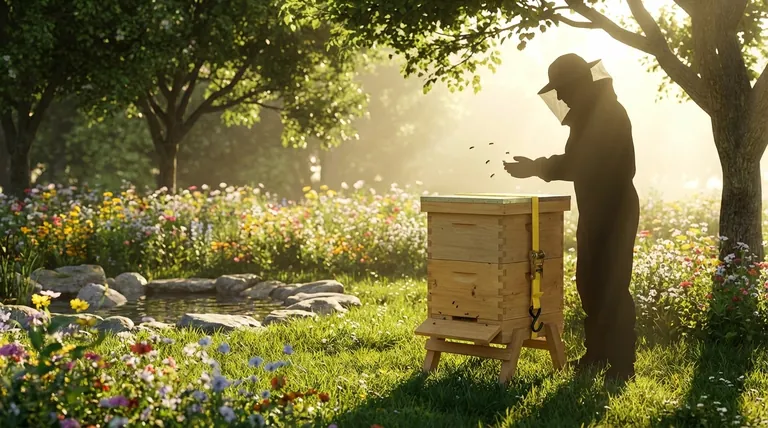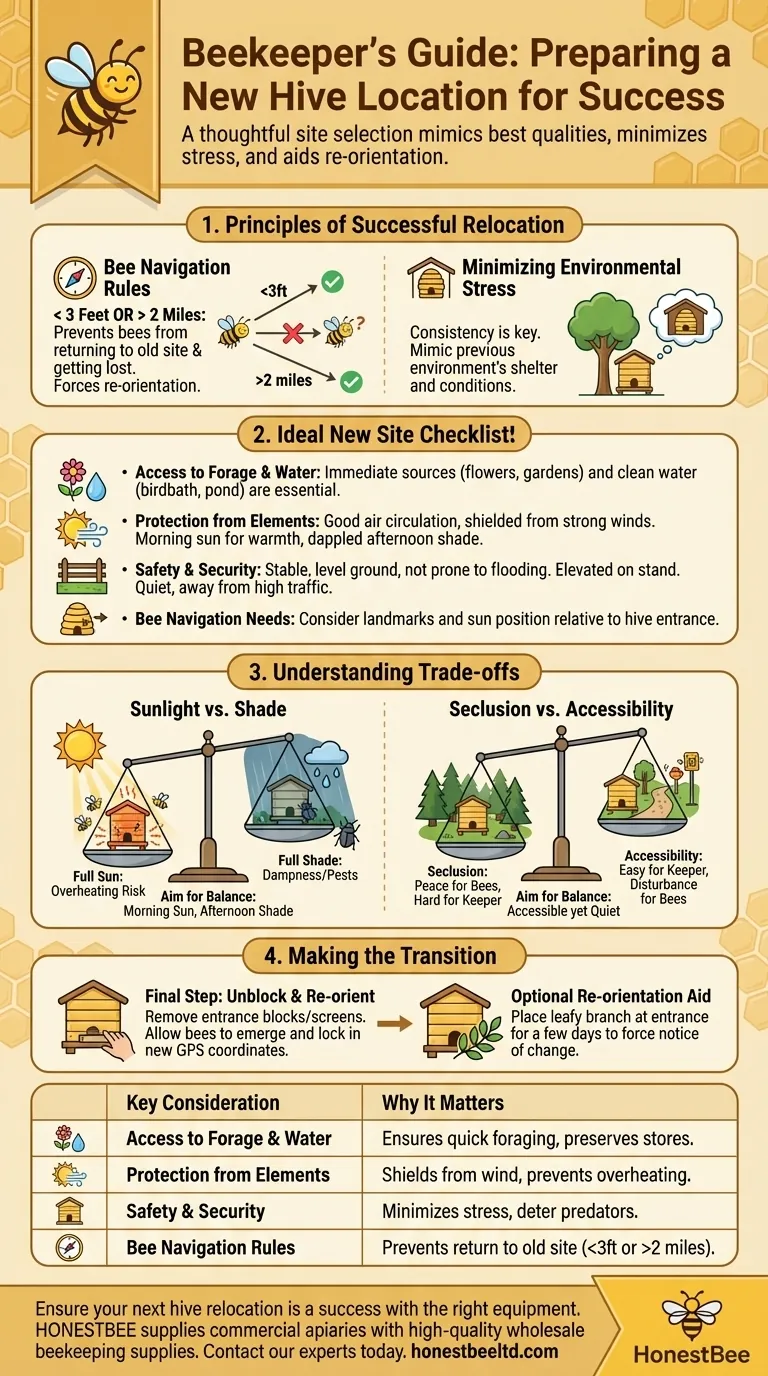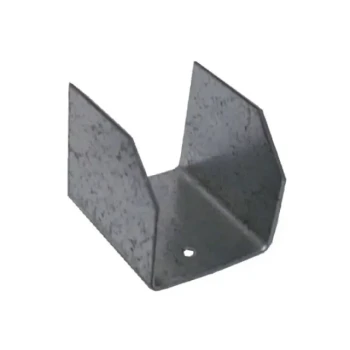To properly prepare a new location for a hive, a beekeeper must prioritize a site that mimics the previous environment's best qualities. The ideal location should be clean, quiet, safe from flooding or extreme sun, and have immediate access to ample food sources like flowers and gardens to help the bees adjust quickly and minimize stress.
The success of a hive relocation is determined before the move ever begins. A thoughtfully prepared new location—one that prioritizes the bees' navigational needs, safety, and access to resources—is the single most important factor in a smooth, low-stress transition.

The Principles of a Successful Relocation
A hive is a superorganism with a precise internal map of its surroundings. Moving it is not like moving a piece of furniture; it's about convincing thousands of individuals that a new place is home. Understanding their needs is paramount.
Understanding Bee Navigation
Bees navigate using a sophisticated internal "GPS" system, memorizing landmarks and the sun's position relative to their hive entrance.
When moved a short distance (more than 3 feet but less than 2 miles), foraging bees will often return to the original hive location, become confused, and perish.
This is why the "less than 3 feet or more than 2 miles" rule is a fundamental concept in beekeeping. A properly selected new site forces them to re-orient and map a new territory.
Minimizing Environmental Stress
A calm, stable environment allows the colony to focus its energy on building comb, raising brood, and gathering resources rather than on thermoregulation or defense.
A new location should offer consistency. If the bees were previously in a sheltered spot, the new one should be as well. This reduces the shock of the transition.
A Checklist for the Ideal New Site
Before you move the hive, scout and prepare the new location with the following criteria in mind. Each point addresses a specific need of the colony.
Access to Forage and Water
Bees need immediate access to nectar, pollen, and water. A site near flowering plants, meadows, or gardens ensures they can quickly resume foraging without depleting their stores.
A nearby water source (a birdbath with stones, a pond, or even a dripping tap) is also essential for drinking and cooling the hive in warm weather.
Protection from the Elements
The hive should be placed in a location with good air circulation but shielded from strong, prevailing winds, which can chill the hive and make flight difficult.
Aim for morning sun to warm the hive and encourage early foraging, but provide dappled afternoon shade to prevent overheating during the hottest part of the day.
Safety and Security
The ground must be stable, level, and not prone to flooding. Placing the hive on a stand elevates it from ground moisture and deters some predators.
Ensure the location is quiet and away from high-traffic areas, such as sidewalks, playgrounds, or patios, to minimize disturbances for both the bees and humans.
Understanding the Trade-offs
No location is perfect. A successful beekeeper understands how to balance competing factors to find the best possible site.
Sunlight vs. Shade
Full, all-day sun can lead to an overheated hive, causing the bees to expend significant energy fanning to keep it cool.
Conversely, full, all-day shade can lead to a damp, cool hive, which is more susceptible to pests like small hive beetles and may result in a less active colony.
Seclusion vs. Accessibility
A remote, secluded spot is excellent for the bees' peace and quiet.
However, it can be problematic for the beekeeper, who needs regular, easy access for inspections and maintenance. Don't choose a site that is difficult to get to with heavy equipment.
Making the Right Choice for a Smooth Transition
Once the hive is physically in its new, prepared location, the final step is to allow the bees to emerge and re-orient.
Remove any entrance blocks or screens and completely unwrap any material used to secure the hive. This signals to the bees that they have arrived and can begin their orientation flights, locking in the new "GPS" coordinates.
- If your primary focus is rapid re-orientation: Place an obstacle like a leafy branch directly in front of the hive entrance for a few days to force the bees to notice the change and map their new surroundings.
- If your primary focus is long-term productivity: Prioritize a location with diverse, season-long forage and excellent protection from your region's harshest weather patterns.
Choosing the right home is the greatest service you can provide your colony during a relocation.
Summary Table:
| Key Consideration | Why It Matters |
|---|---|
| Access to Forage & Water | Ensures bees can quickly resume foraging without depleting stores. |
| Protection from Elements | Shields hive from strong winds and prevents overheating. |
| Safety & Security | A stable, level, and quiet location minimizes stress and predators. |
| Bee Navigation Rules | Moving "<3 ft or >2 miles" prevents bees from returning to the old site. |
Ensure your next hive relocation is a success with the right equipment. A smooth move starts with durable, reliable supplies. HONESTBEE supplies commercial apiaries and beekeeping equipment distributors with high-quality wholesale beekeeping supplies and equipment designed for productivity and colony health. Contact our experts today to discuss your needs and get your apiary thriving.
Visual Guide

Related Products
- Versatile Ratchet Hive Strap with S-Hooks for Secure Fastening
- Professional Galvanized Hive Strap with Secure Locking Buckle for Beekeeping
- Heavy Duty Ratchet Hive Strap
- Endless Loop Ratchet Hive Strap
- Professional Engraved Round Hive Number Tags for Beekeeping
People Also Ask
- What are the types of Emlocks available? Choose the Right Strap for Hive Security
- What are the basic components of beekeeping equipment? Build a Thriving Hive from the Start
- Why should a tie-down strap be used to secure a hive? Protect Your Colony from Tipping and Damage
- What should be done after placing the hive in its new location? Ensure a Smooth Transition for Your Colony
- What is the correct way to install a ratchet strap to reduce freezing in cold weather? Prevent Seizure with Proper Drainage



















